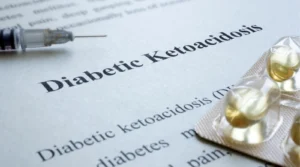Welcome to our comprehensive guide on ketoacidosis, a serious complication that can occur in individuals following a ketogenic diet or those with certain medical conditions such as diabetes. In this blog, we’ll delve into the causes of ketoacidosis and most importantly, effective ketoacidosis treatment strategies. Whether you’re embarking on a ketogenic lifestyle or managing a medical condition, understanding ketoacidosis is crucial for maintaining optimal health and well-being.
Contents
What Causes Ketoacidosis?
 Ketoacidosis is primarily caused by a significant imbalance in the body’s metabolism, leading to the accumulation of ketones and a decrease in pH levels. The main factors contributing to the development of ketoacidosis include:
Ketoacidosis is primarily caused by a significant imbalance in the body’s metabolism, leading to the accumulation of ketones and a decrease in pH levels. The main factors contributing to the development of ketoacidosis include:
- Insulin Deficiency
In individuals with diabetes, especially type 1 diabetes, insufficient insulin levels prevent the body from effectively using glucose for energy. Without enough insulin, cells cannot absorb glucose from the bloodstream, leading to high blood sugar levels (hyperglycemia). In response, the body starts breaking down fat stores for energy, resulting in the production of ketones.
- Excessive Production of Ketones
When the body breaks down fats for energy in the absence of sufficient insulin, it produces ketones as a byproduct. Ketones are acidic compounds that can accumulate in the bloodstream. And, leading to a decrease in pH levels and causing ketoacidosis.
- Dehydration
Elevated blood sugar levels in individuals with diabetes can lead to increased urination (polyuria), resulting in dehydration. Dehydration further exacerbates the imbalance in electrolytes and can contribute to the development of ketoacidosis.
- Illness or Infection
Illnesses such as infections or other medical conditions can increase the body’s demand for energy, leading to higher levels of stress hormones like cortisol. These stress hormones can antagonize the effects of insulin, exacerbating insulin deficiency and promoting ketone production.
- Skipping Insulin Injections or Medication
Intentionally or unintentionally skipping insulin injections or medication doses can lead to uncontrolled blood sugar levels, increasing the risk of ketoacidosis, particularly in individuals with diabetes.
It’s essential for individuals with diabetes to closely monitor their blood sugar levels, adhere to their prescribed insulin regimen or medication, and seek medical attention promptly if they experience symptoms of ketoacidosis.
What Are Some Medical Ketoacidosis Treatment Options?
 Ketoacidosis treatment typically involves addressing the underlying causes, restoring fluid balance, correcting electrolyte imbalances, and normalizing blood sugar levels. Here are some common medical treatment options for ketoacidosis:
Ketoacidosis treatment typically involves addressing the underlying causes, restoring fluid balance, correcting electrolyte imbalances, and normalizing blood sugar levels. Here are some common medical treatment options for ketoacidosis:
Intravenous Fluids
Rehydration is a cornerstone of ketoacidosis treatment. Intravenous fluids, typically containing saline solution, are administered to replenish lost fluids and correct dehydration. Dehydration is common in ketoacidosis due to excessive urination caused by high blood sugar levels. Restoring fluid balance helps improve blood pressure, organ perfusion, and overall tissue hydration, which are essential for proper physiological function.
Insulin Therapy
Insulin administration is essential for lowering blood sugar levels and reversing ketosis. This facilitates the uptake of glucose by cells, allowing them to use glucose for energy instead of breaking down fats and producing ketones. Regular insulin is typically administered through intravenous infusion to ensure rapid and effective reduction of blood sugar levels. Close monitoring of blood glucose levels is necessary to adjust insulin dosages and prevent complications such as hypoglycemia.
Electrolyte Replacement
Electrolyte imbalances, particularly low levels of potassium, sodium, and phosphate, are common in ketoacidosis. Intravenous electrolyte solutions containing potassium chloride, sodium chloride, and potassium phosphate are administered to restore normal electrolyte levels. Electrolytes play crucial roles in nerve conduction, muscle function, and maintaining acid-base balance. Replenishing electrolytes helps prevent complications such as cardiac arrhythmias, muscle weakness, and respiratory failure.
Continuous Monitoring
Continuous monitoring of vital signs, blood glucose levels, electrolytes, and acid-base balance is essential during ketoacidosis treatment. Regular blood tests and monitoring equipment are used to assess the patient’s response to treatment and make necessary adjustments in fluid, insulin, and electrolyte therapy. Close monitoring helps detect complications early and ensures optimal management of ketoacidosis.
Treatment of Underlying Causes
Identifying and treating the underlying cause of ketoacidosis is crucial for preventing recurrence. In individuals with diabetes, optimizing diabetes management through insulin therapy, dietary adjustments, and lifestyle modifications is essential. If ketoacidosis is triggered by an infection or other medical condition, appropriate treatment, such as antibiotics or supportive care, is necessary to address the underlying cause and prevent further complications.
Oxygen Therapy
In severe cases of ketoacidosis, oxygen therapy may be administered to improve tissue oxygenation and alleviate respiratory distress. Oxygen supplementation can help support respiratory function and prevent hypoxemia, which may occur due to respiratory compensation for metabolic acidosis.
Bicarbonate Therapy
In some cases of severe acidosis with extremely low blood pH levels, bicarbonate therapy may be considered. Bicarbonate (sodium bicarbonate) is administered intravenously to buffer excess acid and raise blood pH levels. However, the use of bicarbonate therapy is controversial and generally reserved for patients with severe acidemia or life-threatening complications, as it can potentially worsen electrolyte imbalances and lead to complications such as hypernatremia.
Intensive Care Monitoring
Patients with severe ketoacidosis or those at risk of complications may require intensive care monitoring in a hospital setting. Intensive care units (ICUs) provide specialized care and continuous monitoring of vital signs, organ function, and response to treatment. Close observation in an ICU allows for prompt intervention in case of complications and ensures comprehensive management of ketoacidosis.
Overall, a multidisciplinary approach involving healthcare professionals such as endocrinologists, intensivists, nurses, and dietitians is essential for effectively treating ketoacidosis and preventing serious complications. Prompt diagnosis, appropriate medical intervention, and close monitoring are crucial for optimizing outcomes.
Can Ketoacidosis Be Treated At Home?
Treating ketoacidosis at home is not recommended. Ketoacidosis is a serious medical emergency that requires immediate medical attention and intervention in a hospital setting. Attempting to treat ketoacidosis at home can be extremely dangerous and may lead to life-threatening complications.
Furthermore, ketoacidosis is often associated with underlying medical conditions such as diabetes, which require comprehensive management and monitoring by healthcare professionals. Attempting to manage ketoacidosis at home without proper medical supervision can result in delayed treatment, inadequate management of complications, and potentially fatal outcomes.
What Are Some Strategies To Prevent Ketoacidosis?
 Preventing ketoacidosis involves managing underlying medical conditions, such as diabetes, and adopting healthy lifestyle habits to maintain optimal metabolic function. Here are some strategies to prevent ketoacidosis:
Preventing ketoacidosis involves managing underlying medical conditions, such as diabetes, and adopting healthy lifestyle habits to maintain optimal metabolic function. Here are some strategies to prevent ketoacidosis:
Manage Diabetes Effectively
If you have diabetes, it’s crucial to work closely with your healthcare team to manage your condition effectively. This includes monitoring blood glucose levels regularly, adhering to prescribed insulin regimens or medications, and making appropriate dietary and lifestyle modifications to keep blood sugar levels within target ranges.
Follow a Balanced Diet
Adopting a balanced diet that includes a variety of nutrient-dense foods can help prevent fluctuations in blood sugar levels and reduce the risk of ketoacidosis. Focus on consuming adequate amounts of carbohydrates, protein, and healthy fats, and avoid excessive intake of high-carbohydrate or high-fat foods that can disrupt blood sugar control.
Stay Hydrated
Proper hydration is essential for maintaining normal kidney function and preventing dehydration, which can contribute to the development of ketoacidosis. Drink plenty of water throughout the day, especially if you have diabetes or engage in activities that increase fluid loss, such as exercise or exposure to hot temperatures.
Monitor Blood Glucose Levels
Regular monitoring of blood glucose levels allows you to track changes and make necessary adjustments in insulin dosages or medications to keep blood sugar levels within target ranges. Work with your healthcare team to establish a monitoring schedule and interpret your blood glucose readings accurately.
Exercise Regularly
Engaging in regular physical activity can improve insulin sensitivity, lower blood sugar levels, and promote overall metabolic health. Incorporate a combination of aerobic exercise, strength training, and flexibility exercises into your routine, and aim for at least 150 minutes of moderate-intensity exercise per week, as recommended by guidelines.
Manage Stress
Chronic stress can increase blood sugar levels and exacerbate insulin resistance, increasing the risk of ketoacidosis. Practice stress-reduction techniques such as deep breathing, meditation, yoga, or mindfulness to manage stress effectively and promote emotional well-being.
Follow Medication and Insulin Regimens
Adhere to prescribed medication regimens, including insulin therapy, as directed by your healthcare provider. Skipping doses or failing to take medications as prescribed can lead to uncontrolled blood sugar levels and increase the risk of ketoacidosis.
By implementing these strategies and maintaining regular communication with your healthcare team, you can reduce the risk of ketoacidosis. Hence, effectively manage your overall health and well-being, especially if you have diabetes or other predisposing factors.
Conclusion
In conclusion, ketoacidosis treatment requires prompt medical attention and intervention. Whether you’re managing diabetes or following a ketogenic diet, understanding the signs, causes, and prevention strategies is crucial for maintaining optimal health. By closely monitoring blood sugar levels, staying hydrated, following prescribed medications, and seeking timely medical care, you can effectively prevent ketoacidosis and ensure your well-being.
Remember to work closely with your healthcare team, stay informed, and prioritize your health to minimize the risk of complications and enjoy a healthier, happier life. Do you want to get rid of diabetes? Join our online diabetes treatment program and reverse Diabetes naturally through lifestyle changes such as a Personalized Diet plan, Exercise, Yoga, dieticians, and health coaches.

